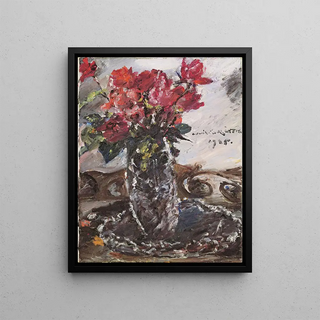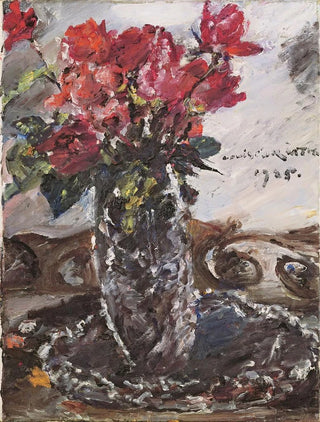Art print | Red roses - Lovis Corinth


View from behind

Frame (optional)
Roses rouges - Lovis Corinth – Captivating Introduction
Lovis Corinth, an iconic figure of the Expressionist movement, masterfully captures the very essence of fleeting beauty through his vibrant works. Among them, "Roses rouges" stands out for its bold palette and sensual approach to nature. This canvas, where flowers bloom in a burst of colors, invites the viewer to immerse themselves in a universe where beauty is expressed with rare intensity. The roses, symbols of passion and delicacy, reflect a suspended moment—a celebration of life and the fragility of existence. By admiring this artwork, one feels a deep connection with nature, an invitation to appreciate the nuances of the reality that surrounds us.
Style and uniqueness of the artwork
Lovis Corinth's style is characterized by an impressive mastery of colors and forms. In "Roses rouges," each petal seems to vibrate under the artist's brush, creating a dynamic that transcends simple floral representation. The brushstrokes, both energetic and delicate, reveal a unique sensitivity, where light and shadow dance across the canvas, giving the piece striking depth. The composition, though traditional in its subject, reinvents itself through the almost tactile expression of the flowers. Corinth manages to infuse these roses with palpable life, making them almost tangible—as if one could smell their enchanting fragrance. This bold and immersive approach makes "Roses rouges" a masterpiece that transcends time and continues to fascinate art lovers.
The artist and his influence
Lovis Corinth, born in 1858, played a decisive role in the evolution of art at the turn of the 20th century. Influenced by the great masters of the past, he developed a distinctive style that combines realism and expressionism. His work is set during a period of artistic upheaval, where conventions were challenged and subjectivity took precedence over objectivity. Corinth was also a mentor to many artists, passing on his passion for color and form. His ability to capture emotion through his subjects,

Matte finish

View from behind

Frame (optional)
Roses rouges - Lovis Corinth – Captivating Introduction
Lovis Corinth, an iconic figure of the Expressionist movement, masterfully captures the very essence of fleeting beauty through his vibrant works. Among them, "Roses rouges" stands out for its bold palette and sensual approach to nature. This canvas, where flowers bloom in a burst of colors, invites the viewer to immerse themselves in a universe where beauty is expressed with rare intensity. The roses, symbols of passion and delicacy, reflect a suspended moment—a celebration of life and the fragility of existence. By admiring this artwork, one feels a deep connection with nature, an invitation to appreciate the nuances of the reality that surrounds us.
Style and uniqueness of the artwork
Lovis Corinth's style is characterized by an impressive mastery of colors and forms. In "Roses rouges," each petal seems to vibrate under the artist's brush, creating a dynamic that transcends simple floral representation. The brushstrokes, both energetic and delicate, reveal a unique sensitivity, where light and shadow dance across the canvas, giving the piece striking depth. The composition, though traditional in its subject, reinvents itself through the almost tactile expression of the flowers. Corinth manages to infuse these roses with palpable life, making them almost tangible—as if one could smell their enchanting fragrance. This bold and immersive approach makes "Roses rouges" a masterpiece that transcends time and continues to fascinate art lovers.
The artist and his influence
Lovis Corinth, born in 1858, played a decisive role in the evolution of art at the turn of the 20th century. Influenced by the great masters of the past, he developed a distinctive style that combines realism and expressionism. His work is set during a period of artistic upheaval, where conventions were challenged and subjectivity took precedence over objectivity. Corinth was also a mentor to many artists, passing on his passion for color and form. His ability to capture emotion through his subjects,






